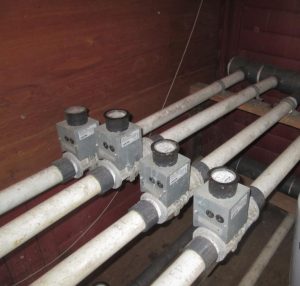How to Address Soil Vapor Intrusion
Discussed in a previous blog (link at the bottom of the page), subsurface contamination can find its way into habitable buildings via minor breaches in a building’s foundation and/or flooring. Source area removal, or direct removal of the contaminated soil and/or groundwater, is the best option for long-term cleanup goals. However, to protect building inhabitants in the interim, installation of a sub-slab depressurization system (SSDS) is a tried and tested method to prevent harmful vapors from entering the building. It is crucial to remember that an SSDS is not the most efficient option for long-term site remediation, although there are some remedial benefits including oxygenating of the contaminants.
Sub-Slab Depressurization Basics
 As its name implies, an SSDS is typically used under any building that sits on a concrete floor. A well-functioning system creates a negative pressure field surrounding the underside of the building, where target VOCs can be “collected” and exhausted to an outdoor, atmospheric vent. An SSDS typically consists of a series of one or more collection and exhaust pipes, paired with a fan to draw air up from under the foundation.
As its name implies, an SSDS is typically used under any building that sits on a concrete floor. A well-functioning system creates a negative pressure field surrounding the underside of the building, where target VOCs can be “collected” and exhausted to an outdoor, atmospheric vent. An SSDS typically consists of a series of one or more collection and exhaust pipes, paired with a fan to draw air up from under the foundation.
Identify Pathways for Vapor Entry
For an existing building, the first step in designing an SSDS is to thoroughly inspect the foundation for any cracking that could act a route for vapor intrusion; once identified, all cracks should be sealed with a non-VOC-containing material to prevent additional gas from entering. This will also help to enhance the negative pressure field beneath the buildings.
Design Process: Test Holes
In order to determine the final location of extraction points, several small diameter test holes (less than one inch) shall be drilled into the building slab to evaluate potential for a negative pressure field. A vacuum is applied to a given hole, and the pressure drops at surrounding holes are measured.
System Installation
Once this analysis is complete, a final extraction point (or points) shall be selected. A hole is drilled into the slab to place the piping; the bottom portion of piping shall be surrounded by crushed stone or similar material for maximum system effectiveness. This piping shall lead to an outdoor exhaust point, where contaminated soil vapors can be exchanged with the open atmosphere.
If desired, the system can be equipped with an alarm to indicate loss of power or vacuum.
Remedial Design Experts
Walden has a team of team of experienced engineers and scientists who can help with SSDS design and other vapor intrusion issues. Please give us a call at (516) 624-7200 to discuss your next job today!
Check out Walden’s previous blog on Soil Vapor Intrusion.
Interested in remedial design? Check out our other environmental consulting services.
